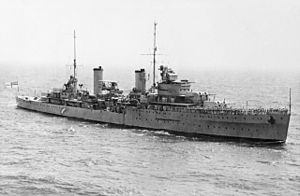Battle of the Strait of Otranto (1940) facts for kids
Quick facts for kids Battle of the Strait of Otranto (1940) |
|||||||
|---|---|---|---|---|---|---|---|
| Part of the Battle of the Mediterranean of World War II | |||||||
 HMAS Sydney in 1940 |
|||||||
|
|||||||
| Belligerents | |||||||
| Commanders and leaders | |||||||
| Strength | |||||||
|
|
||||||
| Casualties and losses | |||||||
| None | 36 killed 42 wounded 4 merchantmen sunk 1 torpedo boat damaged |
||||||
The Battle of the Strait of Otranto was a small but important naval fight during World War II. It happened on November 12, 1940, in the Strait of Otranto, a narrow sea passage in the Adriatic Sea. This battle was part of the larger Battle of the Mediterranean, and it involved ships from Great Britain and Italy.
Contents
Why the Battle Happened
This battle took place when a group of Allied warships, called a squadron, sailed into the Adriatic Sea. Their main goal was to find and attack Italian navy ships.
What the Allied sailors didn't know was that their mission had a secret purpose. They were meant to distract the Italian navy. This distraction would help a much bigger attack happening at the main Italian naval base in Taranto. This larger attack is known as the Battle of Taranto.
The Allied squadron was led by Vice Admiral Henry Pridham-Wippell. His flagship was the light cruiser HMS Orion. The squadron also included:
- The light cruisers HMAS Sydney (from Australia) and HMS Ajax (from Britain).
- The destroyers HMS Nubian and Mohawk.
On November 12, 1940, an Italian Navy convoy was sailing back to Brindisi, Italy. This convoy had four merchant ships: Antonio Locatelli, Premuda, Capo Vado, and Catalani. They were coming from Valona, Albania.
These merchant ships were protected by two other Italian ships:
- The torpedo boat Nicola Fabrizi, commanded by Giovanni Barbini.
- The auxiliary cruiser Ramb III, commanded by Francesco De Angelis.
The Italian ships were traveling in the dark, with no lights on, to avoid being seen.
The Fight Begins
The Allied ships sailed north through the night of November 11. By 1:00 AM, they reached a certain point without any trouble and turned south. About 20 minutes later, they spotted six dark ships. The Allied sailors thought these were two destroyers and four merchant ships. These enemy vessels were crossing in front of them, heading towards the Italian mainland.
At 1:27 AM, the British destroyer Mohawk fired the first shot. Soon, the battle became a general fight.
It was a confusing battle in the dark. The Australian light cruiser HMAS Sydney attacked the first merchant ship from about 11 km (5.9 nmi; 6.8 mi) away. It hit the ship and set it on fire. Over the next 23 minutes, the other three merchant ships were either sunk or badly damaged and left burning.
The Italian torpedo boat Fabrizi was hit and heavily damaged. It managed to limp towards Valona, but 11 of its crew were killed and 17 were wounded. The auxiliary cruiser Ramb III fired 19 shots from its 120 mm (4.7 in) guns. Then, it managed to escape the battle without any damage. All four Italian merchant ships were sunk during the fight.
The Allied ships did not suffer any damage or lose any crew members. However, a torpedo narrowly missed the stern (back) of HMAS Sydney at 1:40 AM. The Italian side had 36 crew members killed and 42 wounded.
What Happened Next
After the battle, the Italian air force, called the Regia Aeronautica, sent planes to find the British naval squadron. However, the CANT flying boats that eventually found the squadron were shot down.
The main Italian Navy, the Regia Marina, also sent ships to try and catch the British squadron. These included:
- Motor torpedo boats from north of Valona.
- Cruiser Squadron 7, with light cruisers Muzio Attendolo, Eugenio di Savoia, and Emanuele Filiberto Duca d'Aosta.
- The 15th Destroyer Division from Brindisi.
- Cruiser Squadron 8, with light cruisers Luigi di Savoia Duca degli Abruzzi and Giuseppe Garibaldi, along with the 7th and 8th Destroyer Divisions from Taranto.
These Italian ships sailed to the Otranto Straits to intercept the British squadron, but they did not manage to find them.
The day after the battle, two Italian torpedo boats, Curtatone and Solferino, rescued a total of 140 sailors who had been in the water.
Ships Involved
Here are the ships that took part in the battle:
- Captain Francesco De Angelis
- Torpedo boat Nicola Fabrizi (damaged)
- Auxiliary cruiser Ramb III
- 4 merchant ships (all sunk):
* Antonio Locatelli (5,691 t (5,601 long tons)) * Premuda (4,427 t (4,357 long tons)) * Capo Vado (4,391 t (4,322 long tons)) * Catalani (2,429 t (2,391 long tons))
Allied Forces
- Rear Admiral Henry Pridham-Wippell
- 3 light cruisers:
* HMAS Sydney (Australian) * HMS Ajax (British) * Orion (British)
-
- 2 destroyers:
* HMS Nubian (British) * Mohawk (British)
Images for kids
-
Ramb III, the only surviving ship from the battle, is now a museum ship called Galeb in Rijeka.


